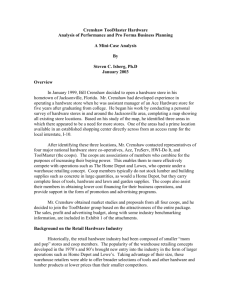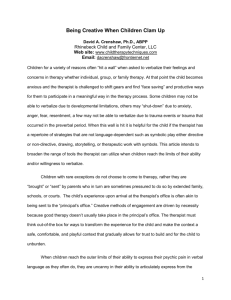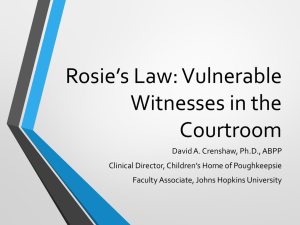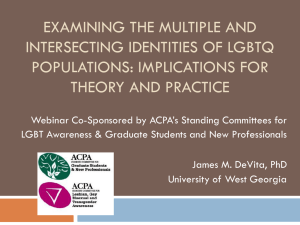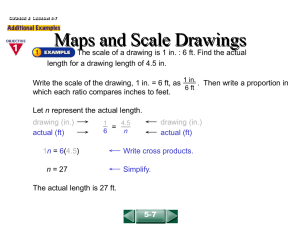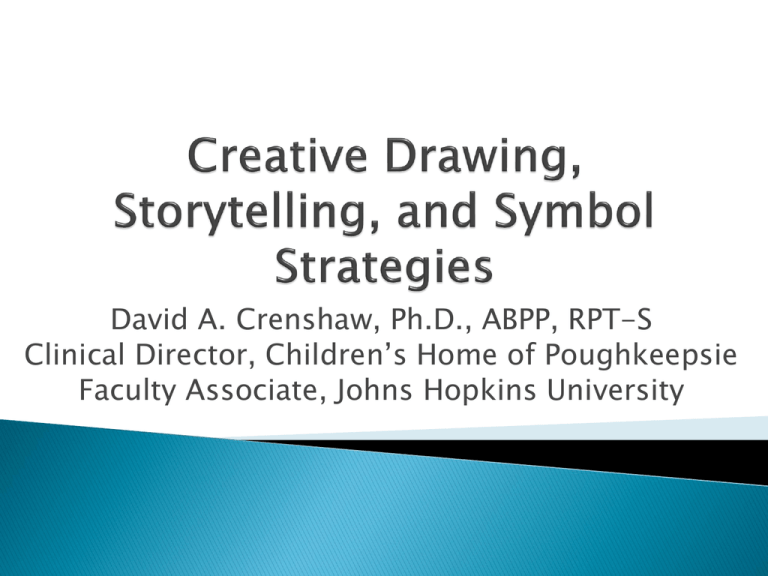
David A. Crenshaw, Ph.D., ABPP, RPT-S
Clinical Director, Children’s Home of Poughkeepsie
Faculty Associate, Johns Hopkins University
Wittgenstein: “You can’t enter any world for
which you don’t have a language.”
“You can’t build loving relationships without a
language for affection” (David Whyte, 2008,
The Three Marriages, New York: Riverhead)
You can’t build therapeutic relationships
without a language for healing. Distinction
between healing and treating.
Self-Calming Rituals
Centering Stones
“Sandy Bottom” (Siegel, Kabat-Zinn)
Creating Safe Places
◦
◦
◦
◦
◦
◦
◦
Build with materials in the room
Create in fantasy
An internal space
With Clay
In Sand
Make a collage
Family Puppet Play
Coping with Dissociation (Yvonne Dolan)
◦
◦
◦
◦
Counting second hands on a watch
Counting fingers
Counting books with blue jackets
Rule of 2/3rds (Kevin O’Connor)
Timing and Pacing
◦ Metaphor of Family Photo Album (Joyce Mills)
◦ Box of “unmentionables”
◦ “Garbage bag” (Beverly James)
Affect Regulation
◦ Volcano Drawings (Eliana Gil)
◦ Storm Drawings (Rage or Terror Expression and
Modulation)
◦ Angry Monster
◦ Fire-Breathing Dragon
◦ Raging Bull
◦ “Party Hats on Monsters” (Crenshaw, 2001)
◦ Projective Drawing and Storytelling: “Blow-Up
Bernie” (Crenshaw, 2008a)
◦ “Downshifting”
Play Strategies
◦ “Alligator goes Ballistic”
◦ “Passport Protected Coping Club”
Cognitive Strategies
◦ Problem solving and develop laminated “Menu of
Best Coping Strategies”
◦ Problems solving and develop laminated “Menu of
Best Coping Statements”
◦ Safety Plan
Learning the Language of Feelings
◦ Feelings Map (Drewes)
◦ Heartfelt Feelings Strategies (HFS)
◦ Expressive Cards in the Heartfelt Feelings Coloring
Card Strategies
Education about Specific Symptoms
◦ Flashbacks (voluntary vs. involuntary subjective
experience—Jay Haley)
◦ Dissociation (when it is helpful—when it is not)
◦ Teach about Defenses (Metaphor of “Fawn in Gorilla
Suit”)
Role Playing
Behavioral Rehearsal
Social Skills Training Groups
Empathy Training Exercises
Recognizing Social Cues
Reading Facial Expressions
Starting and Maintaining Conversations (last 3
particularly valuable with Asperger’s and NonVerbal LD, but aggressive and traumatized child,
highly anxious children as well)
Importance of Humor
Honoring Strengths and Validation
◦ Personal symbol of Unique Genius (David Whyte)
◦ Symbols representing Strengths or Redeeming
Qualities
◦ “Badge of Ability” (Hardy & Laszloffy, 2005)
◦ Projective Drawing and Storytelling: “The Ballistic
Stallion” and “The Wise Ole Owl” (Crenshaw, 2008a)
◦ “Mountain of Strengths” (Crenshaw, 2006)
◦ “Cumulative Strength List (Mordock)
◦ “Superheroes” (Larry Rubin)
Reframing Suffering as Basis of Strength (Ben
Furman)
◦
◦
◦
◦
“Courage Tapes”
Stories of Sports Heroes (Crenshaw & Barker, 2008)
“Three Doors” (Door #1, Crenshaw)
Shifting Identification from Aggressor to
Empowering Helper Role (Kevin O’Connor)
Developing Capacity for Gratitude
◦ “Coins in Fountain”-An exercise in appreciation
(Crenshaw)
◦ “Giving Thanks”
Directed Drawings
◦
◦
◦
◦
◦
◦
“Inside/Outside” (Beverly James, 1989)
“Color-Your-Life” (O’Connor, 1983)
“Boat in Storm” (Oaklander, 1988)
“Your Place” (Oaklander, 1988)
“The Cave” (Crenshaw)
“Serial Drawings” (John Allen, 1988)
Projective Drawing and Storytelling
◦ “The Misunderstood Mouse” (Crenshaw, 2008a)
◦ “The Secret Life of Nicole” (Crenshaw, 2008a)
Clinical Use of Symbols
Child Directed Play
◦ Symbol Association Therapy Strategies (SATS-C)
(Crenshaw, 2008a)
◦ Directed Symbol Work
◦ HFCCS (Relational Strategies)
◦ A Case Example: “Stitches are Stronger than Glue”
Spontaneous Drawings
◦ Clinical Example: “The Dragon in the Well for 150
Years”
Creative Writing
Poetry
Music
Journal Writing
Loss and Grief
◦ “The Magic Key” (Crenshaw, 2008a)
◦ “The Puppy in the Animal Shelter” (Crenshaw,
2008a)
◦ “The Bunny seeking her Mother” (Crenshaw, 2008a)
◦ HFCCS Relational Strategy (“Person who will be in
your heart forever”)
◦ “Heart Symbol Strategies” (Crenshaw)
“The Linking Object” (Crenshaw, 2008a)
◦ Based on psychoanalytic writing of Volkan (1983)
◦ Rationale: Traumatic grief that the child can’t
access, detached or cut-off from feeling. This
disconnection is causing problems in the child’s
functioning and other less evocative strategies
have been tried.
◦ This is an intervention (not a strategy) that
should only be used under supervision or in close
consultation with a colleague
Projective Drawing and Storytelling Strategies
◦ “Fourteen going on Twenty” (Crenshaw, 2006)
◦ “Mike’s Version of Russian Roulette” (Crenshaw,
2008a)
◦ “Eli and Zuko in the Land of Endless Hope”
(Crenshaw, 2006)
Project Approach with Adolescents (unsafe
sex, dangerous driving, alcohol and drug
abuse, eating disorders, self-mutilation, and
suicidal spectrum behaviors)
Projective Drawing and Storytelling
◦ “Jake the Boy who sit alone in the Cafeteria”
(Crenshaw, 2008a)
◦ “The Pig who Didn’t Fit” (Crenshaw, 2008a)
◦ “Behind the Closed Door” (Crenshaw, 2008a)
◦ “The Fair Trial” (Crenshaw & Mordock, 2005b)
Soliciting Prideful Stories with Child and
Family (Fiona True, Ackerman Institute for the
Family)
HFCCS (“Relational--Person who was once in
your heart but no longer is”)
“The Three Doors” (Door #2, Crenshaw, in
press)
Child-Directed Symbolic Play
Clinical Use of Symbols (“The 140lb. Weight
on my Back”)
Projective Drawing and Storytelling
◦ “The Tree on the Hill” (Crenshaw, 2008a)
“Hope can be Dangerous” (Walter Bonime,
M.D. Senior Training Psychoanalyst)
“Magic Stones” (Crenshaw, 2006)
“The Three Doors” (Door #3, Crenshaw, in
press)
Scaling Techniques (Solution-Focused)
“House of Hopes, Dreams, and Promises”
(Crenshaw, 2008a)
“Story of Jose and Pete on the Mountain”
(Crenshaw, 2006)
Countdown
Album
Talk Show
Letter
“One Last Conversation”
“Doing” is the easy part (Crenshaw, 2006,
2008a)
Conversations with Ken Hardy, Eliana Gil, and
Garry Landreth
“Being” is much harder. It takes a certain
maturity and ripening as a therapist to
appreciate the importance of “being” as well
as to realize just how difficult it is to be fully
present in the midst of a child or family’s raw
pain (Crenshaw (ed.) 2008b

